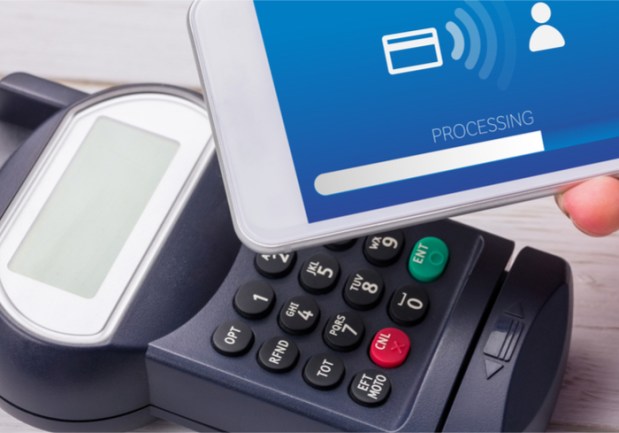North America Is Set To Be An ‘Early Adopter’ Of mPOS

Mobile payment capabilities are on the forefront of retail executives and tech staff. In a survey by Zynstra, some 65 percent of retailers said they pegged mobile payments as their top priority for in-store technology, Chain Store Age reported.
From apparel stores to stadiums, retailers are adopting mobile point of sale (mPOS) systems. And the resulting increase in sales can be impressive: During the first 11 days of the new mPOS initiative, Lilly Pulitzer’s In the Pink stores reported a 24.5 percent increase in sales over the same period previously.
In addition, mPOS systems can provide smoother customer experiences and allow retailers to make better staffing decisions, according to the PYMNTS May mPOS Tracker. Here is what research firms say about the future of mPOS.
Global Wireless POS Market Growth
The global wireless POS terminals market is expected to have a compound annual growth rate (CAGR) of 13 percent from 2017 to 2023. According to a press release from Market Research Future, North America is the leader in the wireless POS market as the region has “advanced technological infrastructure.” As a result, the region can be an “early adopter” of the technology.
However, the company said that Asia-Pacific may see the fastest market growth. Additionally, India, Japan and China may be “the leading countries to be a better prospect region” as the result of governments seeking to encourage a cashless economy. In another report, which was released by Global Market Insights, the CAGR for mPOS was pegged at more than 19 percent from 2016 to 2023.
Card Payment Acceptance
There is a predicted increase of 40 percent in the number of merchant outlets accepting card payments from 2016 to 2022. Thanks in part to new regulations and an increase in financial literacy, RBR projects that payment card acceptance will jump to 85 million outlets around the globe by 2022.
In a press release highlighting the results of its latest forecast, RBR said that regulations and increases in financial literacy are driving the card acceptance around the world. The growth potential is both in the mature markets as well as areas that have high cash-usage rates. In its latest cards research, Global Payment Cards Data and Forecasts to 2022, RBR said the number of card-accepting merchants increased by 7 million in 2016 to 61 million.
Asia-Pacific, Central and Eastern Europe, the Middle East and Africa saw double-digit growth in 2016 — but even with that growth, RBR said the regions are still underserved in terms of card acceptance. As a result, they are expected to be the drivers of global growth going forward.
Mobile Wallets
There is a projected worldwide increase of 30 percent in the number of consumers using mobile wallets from 2017 to 2019. Mobile wallets seemed in need of igniting, but are actually expanding by nearly a third between 2017 and 2019. The news comes from Juniper Research, which found that a little more than 2 billion consumers around the world will use a mobile wallet to make a payment in 2019, compared to 1.6 billion at the conclusion of 2017.
Wallets, such as France’s Orange, add payments with banking offerings to give consumers a more holistic portfolio. Furthermore, successful cases of QR code-based, in-store payments may be limited to closed-loops systems in some markets.
Research Author Dr. Windsor Holden said in the press release, “QR code-based payments are likely to have significant growth in markets, such as India and sub-Saharan Africa, due to the negligible implementation costs. However, their greater susceptibility to alteration, to include viruses and phishing scams, is likely to act as a major deterrent elsewhere.”
Global POS Terminals Market Value
The anticipated value of the global POS terminals market by 2025 will be $116 billion. That figure comes from Grand View Research, and its forecast exhibits an almost 10% CAGR. Demand for affordable wireless technologies, along with mobile terminals, may drive the overall POS market, the company said.
Both chip cards and personal identification numbers (PIN) have helped allay data security concerns. Furthermore, wireless connectivity — such as Bluetooth — and the availability of peripheral devices is also expected to create demand in the market.
In another boost to POS terminals, the Indian government banned high currency notes in 2016 and rolled out a “Digital India” program to help grow a cashless economy. These changes “have significantly boosted demand for POS terminals in India,” the company noted.
Apps — The Most Common In-Person Payment Method
In 5 years, apps are predicted to be the most common in-person payment type in the U.S. The forecast comes from Koski Research’s Future of Money Study. In particular, Peer-to-peer (P2P) payment services might be “well-poised to capture this space,” the company said.
According to the company’s research, more than a third — 36 percent — of Americans reported that they use P2P apps. And they use them mainly for commerce, the study found. Seventy-one percent of Americans used P2P apps to pay for a service or product, while only 31 percent of Americans used the apps to split costs.
Beyond the boost to sales and customer service, mPOS systems have aesthetic benefits: Lilly Pulitzer’s In the Pink stores, for example, were able to gain extra space by implementing one such system.
In The Pink District Manager Jess Newman has said, “We have reclaimed formerly unproductive square feet in the store. Space that once was occupied by servers, wires, printers and other ugly hardware has been turned into beautiful merchandisable space.”